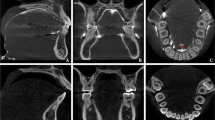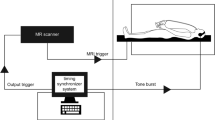Abstract
This study assessed both two-dimensional (2D) TrueFISP imaging for quantifying tongue volume and real-time TrueFISP imaging for evaluating chewing and swallowing in healthy volunteers and patients with acromegaly. In 50 healthy volunteers, tongue volumes were measured using a 2D TrueFISP sequence. Chewing and swallowing were visualized using a real-time TrueFISP sequence. Ten patients with acromegaly were examined twice with the same magnetic resonance imaging protocol: once prior to therapy and a second time 6 months after therapy. Prior to therapy, healthy volunteers had an average tongue volume of 140 ml for men and 90 ml for women, and patients with acromegaly had an average tongue volume of 180 ml for men and 145 ml for women. However, 6 months after therapy the mean tongue volumes in patients with acromegaly had decreased to 154 ml in the men and to 125 ml in the women. The chewing and swallowing process was normal in all volunteers. Prior to therapy, just two patients showed a chewing and swallowing pathology, which disappeared after therapy. Patients with acromegaly had larger tongue volumes than healthy volunteers, and TrueFISP imaging proved feasible for visualizing chewing and swallowing in real time and is capable of detecting possible pathologies. Furthermore, TrueFISP imaging can be used to monitor therapeutic approaches in patients with acromegaly.





Similar content being viewed by others
References
Fazio S, Sabatini D, Cittadini A, et al. (1993) Cardiac effects of GH. Minerva Endocrinol 18:69–75
Fazio S, Sabatini D, Cittadini A, et al. (1993) Growth hormone and the heart. Cardiologia 38:513–518
Fazio S, Cittadini A, Biondi B, et al. (2000) Cardiovascular effects of short-term growth hormone hypersecretion. J Clin Endocrinol Metab 85:179–182
Lombardi G, Colao A, Ferone D, et al. (1996) Cardiovascular aspects in acromegaly: effects of treatment. Metabolism 45:57–60
Herrmann BL, Bruch C, Saller B, et al. (2001) Occurrence of ventricular late potentials in patients with active acromegaly. Clin Endocrinol 55:201–207
Herrmann BL, Bruch C, Saller B, et al. (2002) Acromegaly: evidence for a direct relation between disease activity and cardiac dysfunction in patients without ventricular hypertrophy. Clin Endocrinol 56:595–602
Cook IJ, Kahrilas PJ (1999) AGA technical review on management of oropharyngeal dysphagia. Gastroenterology 116:455–478
Bloem BR, Lagaay AM, Beek W van, Haan J, Roos RAC, Wintzen AR (1990) Prevalence of subjective dysphagea in community residents aged over 87. Br Med J 300:721–722
Grunstein RR, HO KY, Berthon-Jones M, Stewart D, Sullivan CE (1994) Central sleep apnea is associated with increased ventilatory response to carbon dioxide and hypersecretion of growth hormone in patients with acromegaly. Am J Respir Crit Care Med 150:496–502
Dostolova S, Sonka K, Smahel Z, Weiss V, Mrek J, Horinek D (2001) Craniofacial abnormalities and their relevance of sleep apnea syndrome aetiopathogenesis in acromegaly. Eur J Endocrinol 144:91–497
Rosenow F, McCarthy V, Caruso AC (1998) Sleep apnea in active acromegaly. Arch Intern Med 145:865–866
Perks WH, Horrocks PM, Cooper RA (1980) Sleep apnea in acromegaly. Br Med J 280:894–897
Barkhausen J, Goyen M, Winterfeld F, Lauenstein T, Arweiler-Harbeck D, Debatin JF (2002) Visualization of swallowing using real-time True-Fisp MR fluoroscopy. Eur Radiology 12:129–133
Naganawa S, Ishiguchi T, Ishigaki T, et al. (2000) Real time interactive MR imaging system: sequence optimization, and basic clinical evaluations. Radiat Med 18:71–79
Rasche V, Holz D, Proksa R (1999) MR fluoroscopy using projection reconstruction multi-gradient-echo (prMGE) MRI. Magn Reson Med 42:324–334
Lindgren S, Janzon L (1991) Prevalence of swallowing complaints and clinical finding among 50–79-year-old men and women in urban population. Dysphagia 6:187–192
Kennedy JG, Kent RD (1998) Physiological substrates of normal deglutition. Dysphagia 3:24–38
Marciani L, Young P, Wright J, et al. (2000) Echoplanar imaging in GI clinical practice: assessment of gastric emptying and antral motility in four patients. J Magn Reson Imaging 12:343–346
Kunz P, Crelier GR, Schwizer W, et al. (1998) Gastric emptying and motility: assessment with MR imaging—preliminary observations. Radiology 207:33–40
Kunz P, Feinle C, Schwitzer W, et al. (1999) Assessment of gastric motor function during the emptying of solid and liquid meals in humans by MRI. Magn Reson Imaging 9:75–80
Kim AY, Han JK, Seong CK, et al. (2000) MRI in staging advanced gastric cancer: is it useful compared with spiral CT? J Comput Assist Tomogr 24:389–394
Sohn KM, Lee JM, Lee SY, et al. (2000) Comparing MR imaging and CT in the staging of gastric carcinoma. AJR 174:1551–1557
Schmid MR, Hany TF, Knesplova L, et al. (1999) 3D MR gastrography: exoscopic and endoscopic analysis of the stomach. Eur Radiol 9:73–77
Ploutz-Snyder L, Foley J, Ploutz-Snyder R, et al. (1999) Gastric gas and fluid emptying assessed by magnetic resonance imaging. Eur J Appl Physiol Occup Physiol 79:212–220
Marciani L, Young P, Wright J, et al. (2000) Echoplanar imaging in GI clinical practice: assessment of gastric emptying and antral motility in four patients. J Magn Reson Imaging 12:343–346
Bilecen D, Scheffler K, Seifritz E, et al. (2000) Hydro-MRI for the visualization of gastric wall motility using RARE magnetic resonance imaging sequences. Abdom Imaging 25:30–34
Quick HH, Kuehl H, Kaiser G, et al. (2003) Interventional MRA using actively visualized catheters, TrueFISP, and real-time image fusion. Magn Reson Med 49:129–137
Barkhausen J, Goyen M, Rühm SG, et al. (2002) Assessment of ventricular function with single breath-hold real-time steady-state free precession cine MR imaging. Am J Roentgenol 178:731–735
Lauenstein TC, Vogt FM, Herborn CU, et al. (2003) Time-resolved three-dimensional MR imaging of gastric emptying modified by intravenous application of erythromycin. Am J Roentgenol 180:1305–1310
Beer AJ, Hellerhoff P, Zimmermann A, et al. (2004) Dynamic near-real-time magnetic resonance imaging for analyzing the velopharyngeal closure in comparison with videofluoroscopy. J Magn Reson Imaging 22:791–797
Abolmaali ND, Schmitt J, Schwarz W, Toll DE, Hinterwimmer S, Vogl TJ (2004) Visualization of the articular disk of the temporomandibular joint in near-real-time MRI: feasibility study. Eur Radiol 14:1889–1894
Dostalova S, Smahel Z, Sonka K (1998) Craniofacial abnormalities in sleep apnoea syndrome. Acta Chir Plast 40:49–53
Dostalova S, Sonka K, Smahel Z, Weiss V, Marek J, Horinek D (2001) Craniofacial abnormalities and their relevance for sleep apnoea syndrome aetiopathogenesis in acromegaly. Eur J Endocrinol 144:491–497
Ip MS, Tan KC, Peh WC, Lam KS (2001) Effect of Sandostatin LAR on sleep apnoea in acromegaly: correlation with computerized tomographic cephalometry and hormonal activity. Clin Endocrinol 55:477–483
Bacon WH, Turlot JC, Krieger J, Stierle JL (1990) Cephalometric evaluation of pharyngeal obstructive factors in patients with sleep apneas syndrome. Angle Orthod 60:115–122
Hochban W, Ehlenz K, Conradt R, Brandenburg U (1999) Obstructive sleep apnoea in acromegaly: the role of craniofacial changes. Eur Respir J 14:196–202
Hochban W, Brandenburg U (1994) Morphology of the viscerocranium in obstructive sleep apnoea syndrome—cephalometric evaluation of 400 patients. J Craniomaxillofac Surg 22:205–213
Lamberts SW, van Koetsveld P, Hofland L (1989) A close correlation between the inhibitory effects of insulin-like growth factor-I and SMS 201-995 on growth hormone release by acromegalic pituitary tumours in vitro and in vivo. Clin Endocrinol 31:401–410
Melmed S (1990) Acromegaly. N Engl J Med 322:966–977
Author information
Authors and Affiliations
Corresponding author
Rights and permissions
About this article
Cite this article
Ajaj, W., Goyen, M., Herrmann, B. et al. Measuring tongue volumes and visualizing the chewing and swallowing process using real-time TrueFISP imaging—initial clinical experience in healthy volunteers and patients with acromegaly. Eur Radiol 15, 913–918 (2005). https://doi.org/10.1007/s00330-004-2596-6
Received:
Revised:
Accepted:
Published:
Issue Date:
DOI: https://doi.org/10.1007/s00330-004-2596-6




